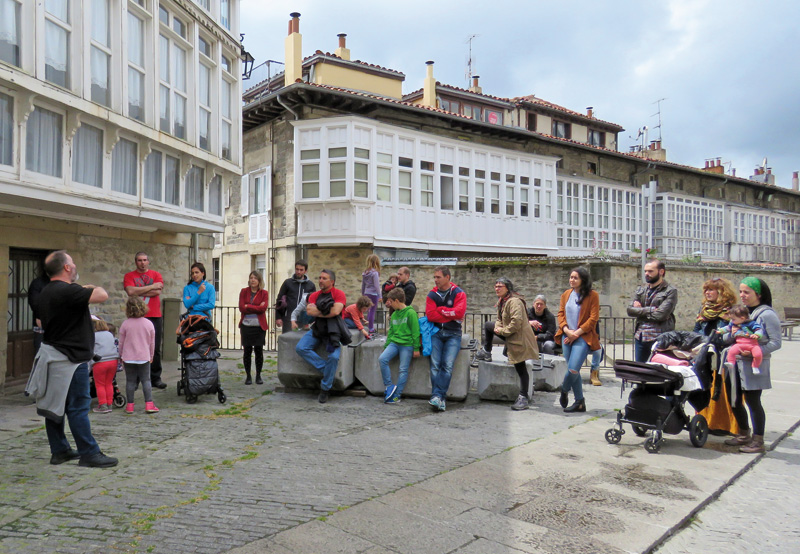
- The disappearance of Euskera in Vitoria-Gasteiz dates back to time immemorial, but there are still many people who believe it disappeared. The testimonies show that this is not the case. The Geu Association offers guided tours in Basque and Spanish to explain the uninterrupted connection between Vitoria-Gasteiz and the Basque Country. At the end of October, they will also take part in the Darija language of North Africa.

Gladys Giraldo Velásquez is Colombian and has been in Vitoria-Gasteiz for many years. He participated in the guided tour they performed in Spanish. Giraldo is frustrated because he doesn't speak Basque, because he hasn't learned. He considers that Euskera is necessary for political, cultural and social reasons. So he took his children to the ikastola, because he thought it was very important that education should be done in Euskera.
The guided tour seemed interesting, “we went to different places and tell fragments of history brings you emotionally, of course history is also important.” Giraldo has highlighted the work done by the Anderers. He knew the Anderers who taught in secrecy, but he did not know the concrete examples of Vitoria, and he found it interesting to put them in names and surnames and place them in concrete streets. She also liked to work with female referents in the history of Euskera: “The references of history are men and the ones of ikastola are women. They took visibility, they showed the daily work, the work of ants.” On the tour, Giraldo not only turned his eyes back, but also got to know things of today and tomorrow: “Before they were clandestine things, but we talk about the ikastola Ramón Bajo and that is today, as the school has become Basque, the D model.”
The children who went to the ikastola among the visitors
Petra Niso, her husband and two other friends also thought about a guided tour. Niso is from Burgos. He and his husband have not learned Euskera, but their children have been taken to the ikastola, “we had political conscience and we did it in favor of the Basque.” The tour remembers the moment when the ikastolas were in hiding.
Most of the people who participated in the program were Giraldo and Niso. Some of them are traditional vitorians, others arrived from Spain in the 1960s and 1970s. Some did not have the opportunity to learn Euskera, and all brought the children to the ikastola.
Was Euskera totally lost in Vitoria?
Why does the Geu association organize such routes? This is the question we have asked of Azaitz Unanue, a member of the Geu association, who currently serves as a guide: “Here it is often heard that the Basque Country was lost a long time ago in Vitoria-Gasteiz, which since the Middle Ages was gradually lost. People will believe that at most they spoke for the last time in the 18th century.” The association wanted to explain the connection between Vitoria-Gasteiz and the history of the Basque Country through testimonies, first in Euskera, for the Euskaltegis, for the teaching centers, for the Mintzalagunes, for the Euskaltzales, and then in Spanish.
The itineraries try to answer questions such as: Why are two names our cities? Vitoria and Vitoria? First dictionary in Basque in Vitoria-Gasteiz! Is that true? Are there any Basque writers in Vitoria? Are there still few Euskaldunes in Vitoria?
The tour takes an hour and a half and does not leave the Casco Viejo. These are six sections: testimonies, teaching and education; social movements; literacy and Euskaldunization of adults; cultural expressions; and institutional agents and new projects.
This project emerged in 2011. Euskaltzaleen Topagunea proposed such a route for the Day of the Mintza in Álava. The Euskaldun Gasteiz tour of yesterday, today and tomorrow has been developed through a script that summarized the history of the Basque Country in Vitoria-Gasteiz.
Urriko 22-23 asteburuan, lehen aldiz darijaz eskainiko dute ibilbidea. Darija arabieraren eratorria da, Afrika iparraldean hitz egiten da, Marokon eta Aljerian batik bat. Sahararrek ere –hassaniera egiten dute–ulertzen dute. Nadia Qourchi izango da gidari lanak egingo dituena. Zumarragan bizi da eta Gasteizen ari da itzulpengintza ikasketak egiten. Euskaraz eta gaztelaniaz eskaintzen den ibilbideko edukiak itzuli ditu dagoeneko, baina berak badaki hainbat egoeratan azalpen gehiago eman beharko dituela, darija hiztunei ezezagunak egingo zaizkielako hainbat kontzeptu. Adibidez, euskaltegiak edo gau eskolak zer diren azaldu beharko du. Urriko saioan gazteak espero ditu Qourchik, “haiek dutelako harreman gehiago euskararekin”.
Darijaz ibilbidea, baina euskara ardatz. Azaitz Unanuek azpimarratu duenez, euskara kohesio tresna gisa landu dute: “Bizi diren lekuko hizkuntzaren egoera, errealitatea, ezagutzen badute, errazago hartuko dute beraien hizkuntzaren kontzientzia ere. Hizkuntzen mapan ariketa horrek integraziorako bidea ematen du”.